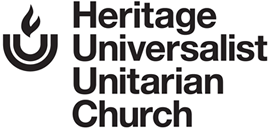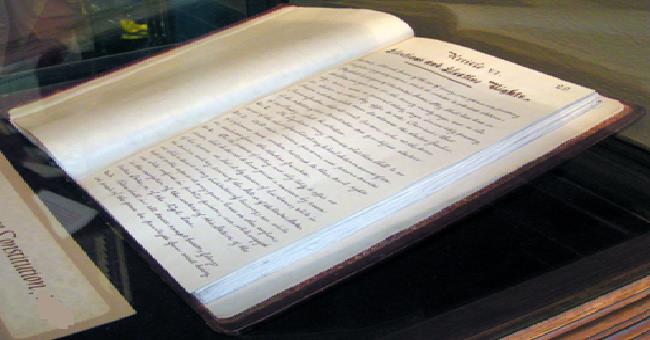by Mike Roberts, Church Historian
I have been reviewing old board minutes from the 19th century. My last examination saw the decade of the 1850s as one of the most tumultuous in the nearly 200-year history of the church. A new house of worship was erected but it only contributed to the financial challenges of the congregation. The roof of the new structure was near collapse only two years after the church opened. Many parishioners were delinquent in their financial commitment to the church. There was great instability in the leadership of the church. Because of these trials, a committee was formed to rewrite the constitution of the First Universalist Society of Cincinnati. The following is a descriptive extract of the nine articles agreed upon by a vote of the entire membership. Contrast how our church might function today if it were governed by these by-laws.
Article I: The object (of the society) shall be the promotion of Christian Faith and Practice by the support of public worship and the preaching of the Gospel.
Article II: All persons shall be deemed members of this society who contribute statedly in the usual mode to its funds. No person shall have a right to vote at its meeting who is six months in arrears.
Article III: The full charge of the business and property of the Society shall be vested in 11 trustees. However, the meetinghouse and real estate of the church cannot be alienated without the consent of 2/3 of the membership. The trustees shall be chosen at the Annual Meeting and hold office for one year. If a vacancy should occur, it will be filled at a meeting to be held within four weeks of the announced vacancy. The trustees shall appoint a President as well as a Clerk and Treasurer who will be from their own number.
Article IV: The annual meetings of the Society will be held on the second Thursday of January. The trustees shall submit a report on the condition of the Society, and of the receipts and expenditures of the previous year. A committee shall examine the financial statement and report back to the trustees or, if deemed necessary, call a meeting of the Society to report their findings. Additional meetings of the Society may be called at the request of the trustees. These meetings must be announced for two successive Sundays before being held. In addition, five members of the Society may call for a meeting. Eleven members will be considered a quorum for a meeting.
Article V: The pastor of the Society shall be chosen by a majority vote of the members and paid a salary agreeable to the members. When a vacancy occurs, it shall be filled at a special meeting of the membership.
Article VI: Amendments to this constitution may be made by a 2/3 vote of those present at any annual meeting.
The obvious intent of this new constitution was to bring some order to the management of its finances and the decision making process of the church. The five years following the adoption of the new document brought little relief. Minister George Flanders, resigned as the church was $600 in arrears of payment of his salary. A member of the church loaned $5,000 to the church to pay off debts and gain some control of its fiscal future.
The board president declared that the church was now in its best financial condition in years. However, within a year, the board of trustees asked permission to offer the church property for sale to pay off its debt. Two offers were made on the property but neither was deemed even close to the value of the building and land, and they refused the offers. As a response to these problems, a new constitution was adopted on January 15, 1862.
In this new constitution, the new Article I was similar to that article from the previous constitution with the exception that there is a much greater emphasis on Christian belief. It sets the tone for the new document.
The new Article II was identified as the church creed. It is worth quoting especially to understand the roots of our Universalist tradition and how that has changed in the 160 years intervening between then and today.
“We hold to and believe in the following sentiments as the basis of our Christian faith. We believe in one God whose nature is love revealed in our Lord Jesus Christ, by one Holy Spirit of Grace, who will finally restore the whole family of mankind to holiness and happiness. We believe that the Holy Scriptures of the Old and New Testaments contain a revelation of the character of God; and the duty, interest and final destination of mankind. We believe that holiness and true happiness are inseparably connected; and that believers ought to maintain order and practice good works, for these things are good and profitable unto man.”
The new Article III stated that members should adhere to the creed in the way they lead their lives and contribute to the welfare of the church. Those who didn’t do so, would have their names struck from the rolls by a majority vote of the membership.
The new Article IV stated that all applications for membership would be sent to the Board of Trustees for determination of the worthiness of potential new members. If approved, their names would be submitted to the society membership for vote. A majority vote was necessary for acceptance.
The new Article V stated that regular meetings of the entire society would be held on the second Wednesday of every month.
The new Article VI made it mandatory that any sale of church property be approved by a 2/3 vote of the members present at a regular meeting.
The new Article VII stipulated that the officers of the society would consist of five trustees, a treasurer, a secretary and three deacons. These officers would be elected or replaced by vote of the society.
The new Article VIII gave the responsibility of hiring a minister to the Board of Trustees subject to the eventual approval of a majority of those present at a society meeting.
The new Article IX allowed any member to withdraw from the society by submitting a letter to the clerk.
These are the roots of our congregation’s Universalist origins. Again, it is interesting to compare where we are now versus where we were from 1857 to 1862.
Image source: https://tinyurl.com/4hunr2tc

